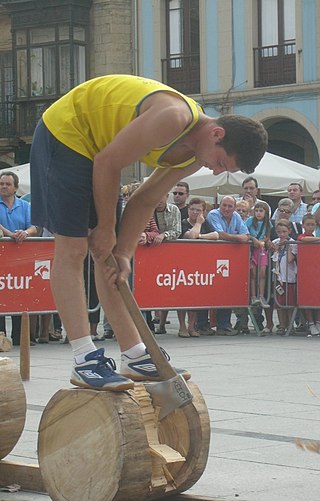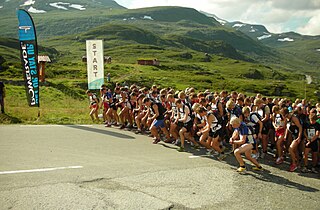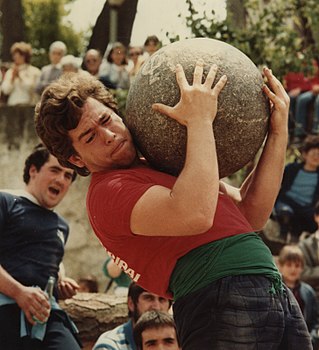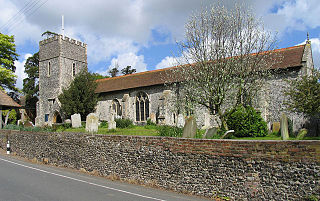
Tug of war is a sport that pits two teams against each other in a test of strength: teams pull on opposite ends of a rope, with the goal being to bring the rope a certain distance in one direction against the force of the opposing team's pull.

Rodeo is a competitive equestrian sport that arose out of the working practices of cattle herding in Spain and Mexico, expanding throughout the Americas and to other nations. It was originally based on the skills required of the working vaqueros and later, cowboys, in what today is the western United States, western Canada, and northern Mexico. Today, it is a sporting event that involves horses and other livestock, designed to test the skill and speed of the cowboys and cowgirls. American-style professional rodeos generally comprise the following events: tie-down roping, team roping, steer wrestling, Steer roping, saddle bronc riding, bareback bronc riding, bull riding and barrel racing. The events are divided into two basic categories: the rough stock events and the timed events. Depending on sanctioning organization and region, other events such as breakaway roping, goat tying, and pole bending may also be a part of some rodeos. The "world's first public cowboy contest" was held on July 4, 1883, in Pecos, Texas, between cattle driver Trav Windham and roper Morg Livingston.

Track and field is a sport that includes athletic contests based on running, jumping, and throwing skills. The name is derived from where the sport takes place, a running track and a grass field for the throwing and some of the jumping events. Track and field is categorized under the umbrella sport of athletics, which also includes road running, cross country running and racewalking.

The caber toss is a traditional Scottish athletic event in which competitors toss a large tapered pole called a "caber" (/ˈkeɪbər/). It is normally practised at the Scottish Highland Games. In Scotland, the caber is usually made from a larch tree and it can be between 16–20 feet tall and weighs 90–150 pounds. The term "caber" derives from the Gaelic word cabar, which refers to a wooden beam.

Woodsman is a competitive, co-ed intercollegiate sport in the United States, Canada and elsewhere based on various skills traditionally part of forestry educational and technical training programs. In North America, the sport currently is organized in five regional divisions: northeastern, mid-Atlantic, southern, midwestern, and western.

Highland games are events held in spring and summer in Scotland and other countries with a large Scottish diaspora, as a way of celebrating Scottish and Celtic culture, especially that of the Scottish Highlands. Certain aspects of the games are so well known as to have become emblematic of Scotland, such as the bagpipes, the kilt, and the heavy events, especially the caber toss and weight over bar. While centred on competitions in piping and drumming, dancing, and Scottish heavy athletics, the games also include entertainment and exhibits related to other aspects of Scottish and Gaelic cultures.

Strength athletics, also known as Strongman competitions, is a sport which tests competitors' strength in a variety of non-traditional ways. Some of the disciplines are similar to those in powerlifting and some powerlifters have also successfully competed in strongman competitions. However, strongman events also test physical endurance to a degree not found in powerlifting or other strength-based sports, such as carrying refrigerators, flipping truck tires, and pulling vehicles with a rope.

Fell running, also sometimes known as hill running, is the sport of running and racing, off-road, over upland country where the gradient climbed is a significant component of the difficulty. The name arises from the origins of the English sport on the fells of northern Britain, especially those in the Lake District. It has elements of trail running, cross country and mountain running, but is also distinct from those disciplines.

Woodchopping, called woodchop for short, is a sport that has been around for hundreds of years in several cultures. In woodchopping competitions, skilled contestants attempt to be the first to cut or saw through a log or other block of wood. It is often held at state fairs and agricultural shows. Participants are often referred to as axemen.

Baton twirling is a sport that combines dance and color guard to create coordinated routines. It requires a "baton" which is metal rod, typically just slightly larger than one's dominant arm. The sport can be seen in national and international competitions including the USA Junior Olympics.

Sport plays a central role in Scottish culture. The temperate, oceanic climate has played a key part in the evolution of sport in Scotland, with all-weather sports like association football and golf dominating the national sporting consciousness. However, many other sports are played in the country, with popularity varying between sports and between regions.

Lifting stones are heavy natural stones which people are challenged to lift, proving their strength. They are common throughout Northern Europe, particularly Iceland, Ireland, Scotland, Basque Country, Faroe Islands, Wales, North West England centred around Cumbria, Switzerland, Germany and also in the United States and parts of Asia such as Japan.
Keg-tossing is a sport that involves the heaving of a standard 15.5 gallon beer keg. Most people would refer to this type of keg as a "half-keg" or "half-barrel." The keg must be completely emptied before it should be tossed to avoid injuries. There are many different types of keg-tossing, as it is practiced throughout the world. In Ireland, the keg is typically thrown over upwards and the height of the toss determines the winner.

Irish stepdance is a style of performance dance with its roots in traditional Irish dance. It is generally characterized by a stiff upper body and fast and precise movements of the feet. It can be performed solo or in groups. Aside from public dance performances, there are also stepdance competitions all over the world. These competitions are often called Feiseanna. In Irish dance culture, a Feis is a traditional Gaelic arts and culture festival. Costumes are considered important for stage presence in competition and performance Irish stepdance. In many cases, costumes are sold at high prices and can even be custom made. Each costume is different, with varying colors and patterns, designed to attract the judge's eye in competitions and the audience's eye in performance. General appearance beside the costume is also equally important. Female dancers would typically curl their hair before each competition or wear curled wigs, while male dancers would neatly style their hair to a shape to their liking. Poodle Socks are worn by female dancers while males wear plain black socks. Poodle socks are white socks that stretch to typically 1-4 inches above the ankle, depending on the dancers preference. They also have distinctive ribbing, and can be embroidered with gems.

Staple is a village and civil parish in east Kent, England. The village lies southwest of the nearby village of Ash and the town of Sandwich, and east of Canterbury.

Basque rural sports, known as Deportes Rurales in Spanish or Herri Kirolak in Basque, is the term used for a number of sports competitions rooted in the traditional lifestyles of the Basque people. The term force basque is used in French.

The Pan Celtic Festival is a Celtic-language music festival held annually in the week following Easter, in Ireland, since its inauguration in 1971. The first Pan Celtic Festival took place in Killarney, County Kerry, Ireland. Its aim is to promote the modern Celtic languages and cultures and artists from six Celtic nations: Brittany, Cornwall, Ireland, Isle of Man, Scotland and Wales.

The Highlander Challenge World Championships is a tournament that marries traditional Highland games with more contemporary strength athletics. It was created to help reinvigorate Highland games in Scotland by giving a modern and aspirational image while maintaining the tradition inherent in the history of the sport.

The Scotland County Highland Games, or SCHG, are a Scottish event held in Laurinburg, North Carolina, United States. Each year, the games are held the first weekend of October at the John Blue House and Grounds in Laurinburg. The event was started in 2009 after the Flora MacDonald Games in Red Springs, North Carolina were discontinued.

Throwing sports, or throwing games, are physical, human competitions where the outcome is measured by a player's ability to throw an object.


















